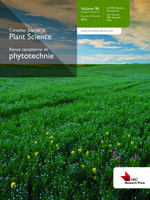Cogliatti, M., Bongiorno, F., Dalla Valle, H. and Rogers, W. J. 2011. Canaryseed (Phalaris canariensis L.) accessions from nineteen countries show useful genetic variation for agronomic traits. Can. J. Plant Sci. 91: 37-48. Fifty-seven accessions of canaryseed (47 populations and 10 cultivars) from 19 countries were evaluated for agronomic traits in four field trials sown over 3 yr in the province of Buenos Aires, Argentina. Genetic variation was found for all traits scored: grain yield and its components (grain weight, grain number per square meter, grain number per head and head number per square meter), harvest index, percent lodging, and phenological characters (emergence to heading, emergence to harvest maturity and heading to harvest maturity). Although genotype×environment interaction was observed for all traits, the additive differences between accessions were sufficient to enable promising breeding materials to be identified. Accessions superior in performance to the local Argentinean population, which in general gave values close to the overall mean of the accessions evaluated, were identified. For example, a population of Moroccan origin gave good yield associated with elevated values of the highly heritable character grain weight, rather than with the more commonly observed grain number per square meter. This population was also of relatively short stature and resistant to lodging, and, although it performed best when sown within the normal sowing date, tolerated late sowing fairly well. Other accessions were also observed with high grain weight, a useful characteristic in itself, since large grains are desirable from a quality point of view. Regarding phenology, the accessions showed a range of 160 degree days (8 calendar days in our conditions) in maturity, which, while not large in magnitude, may be of some utility in crop rotation management. Some accessions were well adapted to late sowing. Grain yield in general was strongly correlated with grain number per square meter. Principal components analysis (PCA) carried out for all characteristics provided indications of accessions combining useful characteristics and identified three components that explained approximately 70% of the phenotypic variation. Furthermore, a second PCA plus regression showed that approximately 60% of the variation in grain yield could be explained by a component associated with harvest index and grain number per square meter. Pointers were provided to possible future breeding targets.
How to translate text using browser tools
1 January 2011
Canaryseed (Phalaris canariensis L.) accessions from nineteen countries show useful genetic variation for agronomic traits
M. Cogliatti,
F. Bongiorno,
H. Dalla Valle,
W. J. Rogers
ACCESS THE FULL ARTICLE
It is not available for individual sale.
This article is only available to subscribers.
It is not available for individual sale.
It is not available for individual sale.





